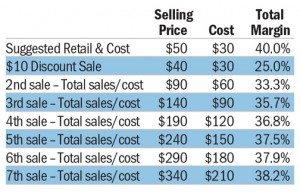5 ways to improve PG&A profits, customer satisfaction
One of our sayings is: “Nothing happens until something is sold.” You can do all the inventory control you want, but unless you train your staff to do a good job of selling and taking care of your customers, you won’t maximize the capabilities of your department.
You must also have an efficient process in place to take care of your largest parts customer — the service department. You can significantly improve sales and customer satisfaction for both departments by helping service sell more labor and fulfilling their parts orders on a timely basis.
Here are five areas of focus that can improve your sales, profits and customer satisfaction.
 1. Recognize the true cost of discounting and implement processes to control it. This chart represents an ATV accessory with a $50 retail price and $30 cost. If sold at full retail, the gross profit would be $20, for a margin of 40 percent.
1. Recognize the true cost of discounting and implement processes to control it. This chart represents an ATV accessory with a $50 retail price and $30 cost. If sold at full retail, the gross profit would be $20, for a margin of 40 percent.
• The first example shows a retail sale with a 20 percent discount ($10 off).
• If the department goal was to achieve a 40 percent margin, it would take seven sales at full retail just to bring it back to 38.2 percent!
How do you control this? Start by using this example with your staff to educate them on how just one discount impacts gross profit margins. Share how the department’s expenses, including their compensation, are paid by gross profit. Establish security settings in your DMS to block their ability to discount without approval from the parts manager. Use the DMS reports to monitor all discounts.
2. Improve customer satisfaction and retention by demanding a culture of professionalism. This includes a lot of “pieces” that must work together to create the proper atmosphere.
• Have a written customer greeting policy.
Include things such as how soon someone should acknowledge customers (example: “5-Foot Rule” — whenever someone comes within five feet of a staff member) and what should be said (example: “Hi, I’m Jeff in parts. What might I help you with?” or “I’ll be right with you…”).
• Have a written telephone answering script.
Many stores have a short script next to every phone in the dealership. The script should include your store name, the person’s name and department, and an open-ended question. Example: “Thanks for calling Bob’s Motorcycle Store; this is Jeff in parts, what can I help you with today?”
• Require a presentable appearance, including uniform shirts and nametags.
This is professionalism 101 — it should be a non-negotiable standard for any dealership.
• Provide sales and customer relations training to your customer-facing staff.
Some dealers just hire minimum-wage kids and hope they develop some sales skills. The PG&A department is the single largest producer of gross profit in your business. If you want more sales, increased profits and higher CSI scores, hire people with the right attitude and aptitude, pay them appropriately and train them to take care of your customers’ wants and needs.
3. Provide your P&A staff with add-on and up-sell training. This ongoing type of training should include periodic drills to ensure they “get it.” One popular add-on exercise is the “Gimmie 5” where the parts manager asks a staffer: “Gimmie 5 add-ons or an upsell you could suggest to a customer that relate to (this part or accessory).” Lean on your OE and aftermarket P&A reps to provide this type of training as well.
4. Promote installation with most accessory sales. A lot of accessory items sold over the counter are being installed by someone else after the customer leaves your store.
• Have service provide parts with menu prices for installing popular accessory items.
• Provide signage for accessory displays that includes “installed” prices.
• Use incentives (can be provided by service) to encourage parts staff to sell labor with accessories. Some dealers set these up as standard jobs in the DMS.
5. Implement effective parts-to-service processes to increase customer retention, CSI and sales. On average, service represents 44 percent of a dealership’s total PG&A sales (source: YE 2013 GSA National Norms). Studies show that a customer’s service experience has a major impact on their decision to purchase again from your store — parts availability can play a big part in that experience. Here are some key processes to consider:
• Establish a dedicated parts-to-service person. The shipping/receiving person might be a good choice since he or she has first access to parts shipments.
• Stock adequate levels of common, high-turn service parts.
• Provide an inventory of common service parts near the access window to service.
• Don’t hold service parts orders for free-freight qualifiers. This can create major customer issues. It can tie up hundreds of dollars on an RO, not to mention wasting valuable service time moving units on/off benches and into/out of storage.
Steve Jones is senior projects manager at Gart Sutton & Associates. He has worked in the powersports industry for more than 30 years, for dealerships and manufacturers, and as a consultant and trainer. Contact him at steve@gartsutton.com.








